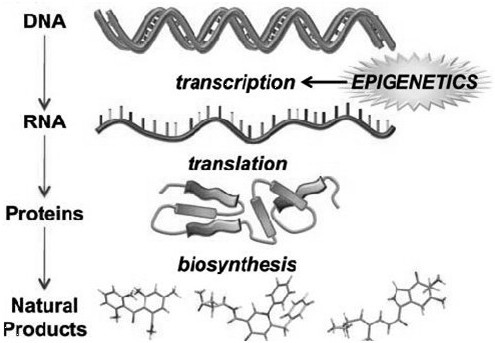Method for regulating fermenting microorganisms using epigenetic modification
A technology for epigenetic modification and fermentation of microorganisms, which is applied in the direction of microorganism-based methods, biochemical equipment and methods, microorganisms, etc., can solve the problems of low activity and low amount of substances, and achieve low biological activity, increased activity, and low cost. cheap effect
- Summary
- Abstract
- Description
- Claims
- Application Information
AI Technical Summary
Problems solved by technology
Method used
Image
Examples
Embodiment 1
[0017] The method of using epigenetic modification to regulate fermentation microorganisms, the specific operation steps are:
[0018] 1) Expansion cultivation: Inoculate Aspergillus terreus in the sterilized and cooled medium for expansion cultivation. The composition of the expansion medium and its parts by weight are: 15~25 parts of mannitol, 2~5 parts of yeast extract, 0.1~0.8 parts of sulfuric acid Magnesium, 8~15 parts of monosodium glutamate, 9~20 parts of glucose, 02~1.1 parts of potassium dihydrogen phosphate, 18~25 parts of maltose, 0.8~1.5 parts of corn steep liquor, 30~40 parts of seawater. The culture temperature is 25-40°C, the pH is 6.5-7.5, and the culture time is 20-40 days. The above medium can well satisfy the nutrients and growth factors required for the growth and reproduction of the symbiotic microorganisms of Enteromorpha enteromorpha, accelerate its growth and reproduction, and shorten the time required for the experiment;
[0019] 2) Epigenetic modifi...
Embodiment 2
[0021] The method for using epigenetic modification to regulate fermenting microorganisms, the most preferred steps are:
[0022] 1) Expansion cultivation: Inoculate Aspergillus terreus in the sterilized and cooled medium for expansion cultivation. The composition of the expansion medium and its most preferred parts by weight are: 20 parts of mannitol, 3 parts of yeast extract, 0.3 parts of magnesium sulfate, 10 parts of MSG, 12 parts of glucose, 0.5 parts of potassium dihydrogen phosphate, 20 parts of maltose, 1.0 part of corn steep liquor, 33 parts of seawater. The culture temperature was 28°C, the pH was 7.0, and the culture time was 30 days. The above-mentioned medium can well meet the nutrients and growth factors required for the growth and reproduction of the symbiotic microorganisms of Enteromorpha enteromorpha, accelerate its growth and reproduction, and shorten the time required for the experiment;
[0023] 2) Regulation of epigenetic modification: add fungal liquid cu...
PUM
| Property | Measurement | Unit |
|---|---|---|
| diameter | aaaaa | aaaaa |
Abstract
Description
Claims
Application Information
 Login to View More
Login to View More - R&D
- Intellectual Property
- Life Sciences
- Materials
- Tech Scout
- Unparalleled Data Quality
- Higher Quality Content
- 60% Fewer Hallucinations
Browse by: Latest US Patents, China's latest patents, Technical Efficacy Thesaurus, Application Domain, Technology Topic, Popular Technical Reports.
© 2025 PatSnap. All rights reserved.Legal|Privacy policy|Modern Slavery Act Transparency Statement|Sitemap|About US| Contact US: help@patsnap.com

